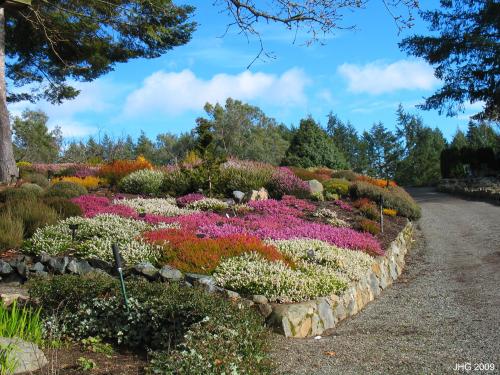Victoria has a reputation of being thought of as being the most ‘English’ of North American cities, therefore, you would expect to find the most ‘English’ of all plants commonly planted here. It is true that Erica carnea or Winter Heath(Heaths have needle like foliage and Heathers have scales) is planted here, it’s not very common and good Heather gardens are hard to find at all. The best one which I know of is the Heather garden at Glendale Gardens in Saanich. This garden covers the range of species which are commonly called Heather including other Ericas, Calluna and Daboecia.

Heathers at Glendale Garden
Erica carnea is the most adaptable of all the heaths. This type of Heath originally comes from southeastern France and grows east toward Switzerland and southern Germany to Austria then south to Yugoslavia. It is found in mountainous areas which is why it is more cold hardy than other Heaths (zone 4-8).
Erica carnea varieties are low growing shrubs that are no more than 8in.(20cm) tall with a spread of 22in.(55cm) at the most. They have a fine texture being that they have fine needle-like foliage and delicate racemes of tiny colorful bell shaped blossoms.

Flower and foliage fo Erica carnea Isobel
Erica carnea blooms in the darkest, coldest months of winter and is often seen happily poking up through a blanket of snow in full flower. Since it was introduced into Britain in 1763 there have been over 100 cultivars selected with flowers ranging in color from white through to strong red purples as well as those with unusual foliage colors. The most commonly seen cultivars in Victoria are ‘Springwood White’ and ‘Springwood Pink’ which is light pink, ‘King George’ that is mid pink and ‘Vivellii’ which has a rich pink flowers.

E.c. 'Springwood White' the purest of the Whites
The needle-like foliage also can be selected for its color effects. It normally is a fine mid to dark green hue, but varieties such as ‘Aurea’ have a lime yellow color in the summer that turns a more golden tone as the weather cools. E.c. Bell’s Extra Special is similar and has reddish blossoms.

E.c Bell's Extra Special foliage color.
Heaths are long lasting plants which look best in a bed completely devoted to heathers species. A few smaller conifers and bulbs such as daffodils are suitable to add. Careful selection can create an ever change display of color both in foliage and flowers throughout the year.

Dazzling color display with a dwarf conifer in the background.
These are low maintenance plants which can be lightly pruned soon after blooming. It also will grow in a wider range of soil types and does not need an exclusively acidic site. They do not tolerate drought as they are shallow rooted therefore adding some peat for moisture retention is a good idea. Also plant them so their foliage rests on the soil. They require full sun for the best growth. For best impact plant in groups of 5 in a single type, a bed can be made up of several groupings like this. Mass plantings are very common as well. Single plants can be used with great effect in rock gardens.
The Links of the Week
Glendale Gardens in Saanich is where all the pictures here come from.
http://www.hcp.bc.ca/index.php
To learn more about Heath and Heathers go to The Heather Society
http://www.users.zetnet.co.uk/heather/
Royal Horticultural Society page on Erica carnea.
http://www.rhs.org.uk/WhatsOn/gardens/harlowcarr/archive/harlowcarrpomfeb.asp
Until we meet again next Sunday at this time…..
Read Full Post »




























 Stumble It!
Stumble It!






